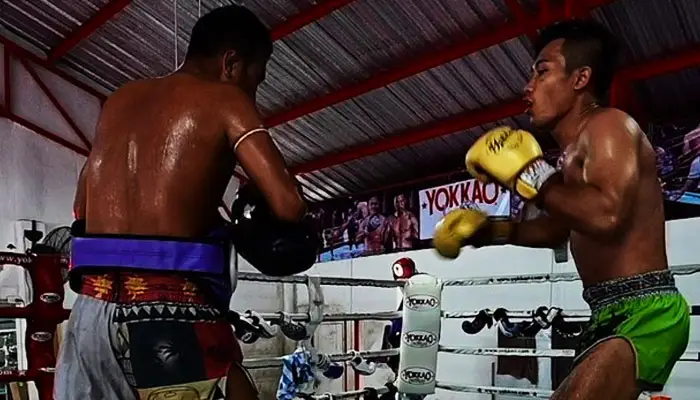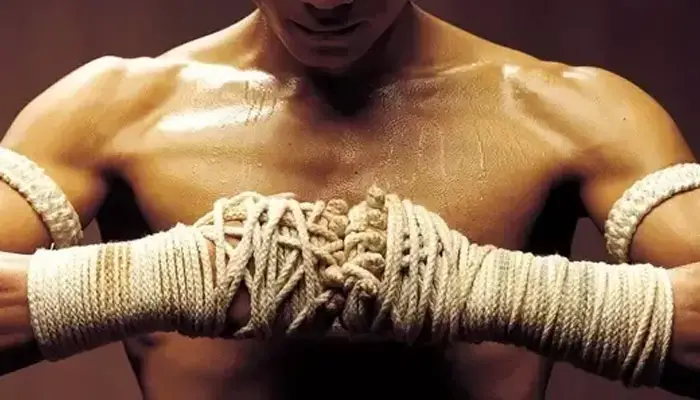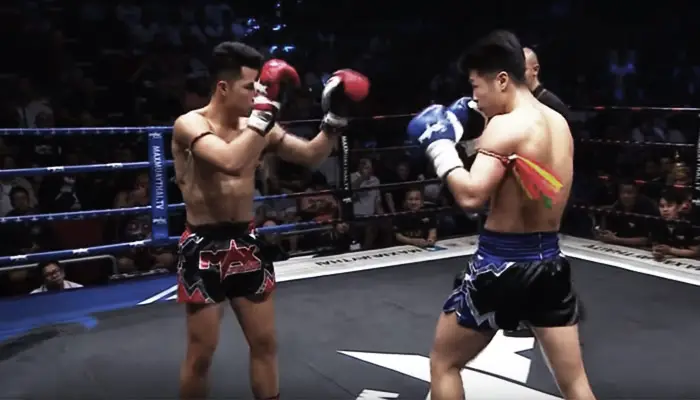Muay thai boxers are some of the toughest fighters out there. They are the best at what they do and their conditioning makes you think how do muay thai fighters train? Traditional gyms in Thailand stick to basic training routines and focus on putting hours in at the gym. The following is a breakdown of how the pros train.
Pro fighters will put in two sessions a day, one in the morning and one in the afternoon. Some will even do three sessions in a day in the heat and humidity.
Each session takes up to two hours and is broken up into rounds. The rounds are three minutes long to reflect the length of a round in a pro fight.
In this Article
Morning Session
Morning sessions typically include roadwork, possibly because it’s not as hot as running in the midday heat. After running, a lighter workout is done.
Roadwork: 3-5 Miles Long Distance Followed By Sprints
Conditioning plays a huge roll in a fighter’s game. It can be the difference between winning a fight or getting tagged with a knockout kick because you were too tired to keep your hands up.
Traditional Thai fighters start the day with a 3-5 mile run on pavement. Long distance running is a type of aerobic exercise. It uses oxygen and builds up your cardio working capacity or “gas tank”.
Both sparring and pad work are forms of anaerobic exercise. You do high-output work in a short amount of time. This is why long distance running compliments fight training so well. Despite this, some camps will also add sprints to increase VO2 max, your bodies ability to use up oxygen.
Shadow Boxing: 2 Rounds
Upon returning to the gym, you shadow box. Shadow boxing is a good way to visualize yourself in a fight and mentally prepare yourself for a grueling training session.
You should be doing shadow at a slower pace and lower intensity. Focus on moving around in the ring and perform techniques with perfect form.
Slip, parry, and check kicks. Mix it up and add defensive techniques, remember you’re trying to visualize yourself in a match.
Thai Pad: 3-5 Rounds
Rounds on the Thai kicking pads will help you practice your timing, technique, and distance control. It will also push your cardio even further.
Typically your pad holder will call out techniques and you hit the pads, but some advanced holders will let you freestyle and flow. A good pad holder will keep up a good pace and also throw some attacks to check your defense.
Sometimes holders will add a finisher exercise like continuous kicks to end the pad session.
Heavy Bag: 5 Rounds
On the heavy bag, you work different combos at a slower pace than on the pads.
Try moving and cutting different angles and use all eight limbs. You might also have the option of training on different types of bags such as banana bags, teardrop bags, wall-mounted bags, and pole bags.
This is a chance to get your second wind before finishing the workout, but don’t ease up too much.
Clinching: 3-5 Rounds
Thais are known for their clinch, and it wouldn’t be a real traditional muay thai training session without clinch work. I get it, it’s almost the end of the workout and you’re feeling gassed. You’ll be clinching while in fights, so this is a good situation to train.
Work on technique and leverage instead of purely out muscling your training partners. Try to lead with knees, if you can’t then try to follow up your partner’s knees one-for-one. Hit with the inside of your thigh when training so you don’t injure your partner (or he injures you).
Cooldown
Some really light shadow boxing can help lower your heart rate and flush out some lactic acid. Stretching and mobility exercises will help open up your muscles and increase range of motion.
After the morning session, you should definitely relax and prepare for the afternoon session. Have a light meal or even meditate.
Afternoon Session
The afternoon session is typically harder than morning training. This session is almost the same as the morning session with two exceptions: skipping and sparring.
Instead of going for a long run, some fighters opt to skip rope. And, instead of going hard on the Thai pads, you spar or do drills with partners. Everything else is more or less the same: shadowboxing, heavy bag work, clinching, and cool down.
Skipping Rope: 5 Rounds
Skipping rope is a great way to build powerful calves and shins. It will help your footwork and agility in the ring.
Thai boxers will usually use weighted jump ropes for the added challenge.
Sparring or Drills: 5-10 Rounds
Sparring with partners is what makes the afternoon sessions harder. Most gyms won’t spar every single day and will sometimes do partner drills instead.
Work on attacking and defending from different angles. Counterattack. Throw longer combos.
Now is the time to mix it up and try different techniques that you don’t normally get to try in the ring. You can either keep in playful or go hard, it depends on your training partner or coach.
Traditional Thai Training vs Western Muay Thai Training
In my experience, western fighters put more of an emphasis on strength and conditioning exercises. Fighters, who can afford it, work with coaches and nutritionists who have science-based backgrounds to create training and nutrition plans.
Here’s an example fighter workout program that was created specifically for fighters. It features different drills and exercises to improve stability, injury prevention, and acceleration all for the unique sport of fighting.
What Thai fighters do well is work the fundamentals. There’s nothing fancy about putting time in the gym and working on the basics, but it works. If anything it helps with grit: you’re ability to grind out and stick to something hard.
Sources:





